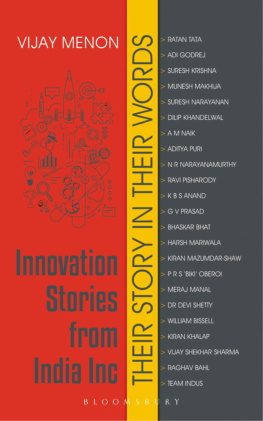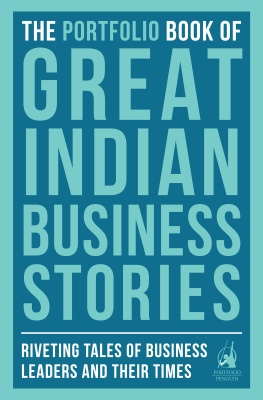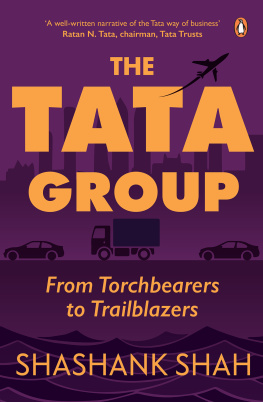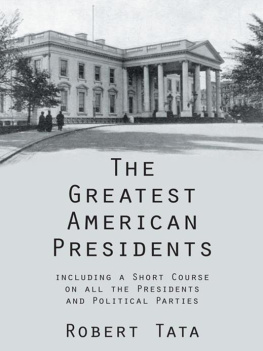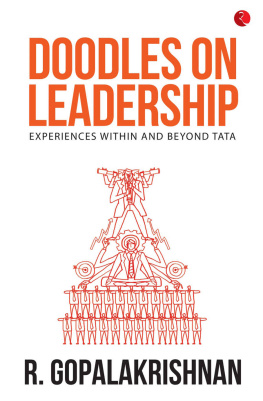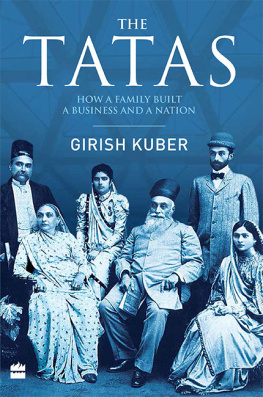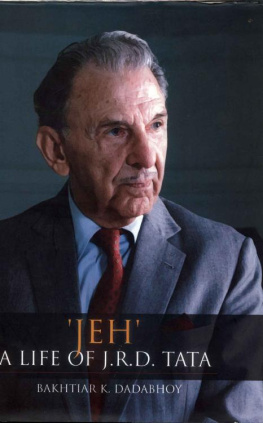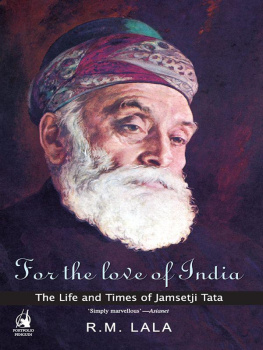Table of Contents
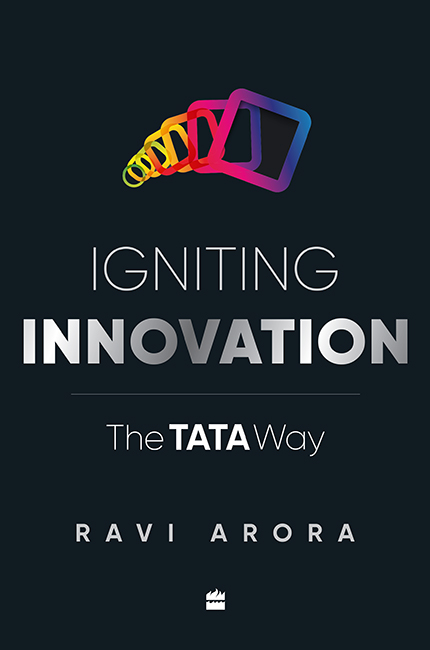
IGNITING
INNOVATION
The Tata Way
RAVI ARORA

There is innovation, there is a fence
the other side is boring immense
I dedicate this book to YOU
for the innovation sport that you brew
and for encouraging innovators in your crew
Keeping yourself afloat in the midst of the grind,
you created the credo luck favours the ignited mind
I also dedicate this book to my two chance encounters
One, with the subject of innovation that put so much on my counter
Two, with the sudden growth of spinal disc C6-C7
which made yoga and writing my go-to safe haven
CONTENTS
Assuming this is not the first piece you are reading on innovation, I would like you to recall any speech that you may have heard or any article or book that you may have read on innovation. It is likely that the one thing you might still remember is the amount of stress the speaker or author had put on the importance of culture for innovation. You might also recall a few attributes of this culture, examples being a culture that allows people to experiment without fear of failure and a culture that encourages people to share their ideas fearlessly. But do you recall reading about or listening to how these attributes get constructed or created?
After spending a considerable amount of time in our respective organizations, many of us form an opinion on how prevalent these attributes are in our teams. We may also have anecdotes to support our opinion. How helpless do we feel when actions are needed to strengthen these attributes? The creation of a culture in an organization is a perpetual process. Depending on the size, age and spread of the organization, it may take several years or decades for a cultural attribute to manifest. The majority of the cultural attributes get created unconsciously, and sometimes consciously, only when the organization follows a set of practices rigorously or experiences consistent and prolonged leadership behaviour.
In 2005, Tata groups leaders began to rediscover their innovation capability. At that time, there were no ways and means to measure and compare the performance of companies on innovation. Ratan Tata, chairman of Tata Sons (also referred to as group chairman) realized the critical role that innovation would play in the twenty-first century. He believed that in a large group around 100 companies and about 250,000 employees the only way to bring in innovation was to first create a culture of innovation.
This book highlights the key attributes of the innovation culture and explains how these can be created and disseminated by any organization. The book draws lessons from real innovative endeavours in Tata companies. The results are similar across the companies, regardless of size, age, industry, and geographical location, indicating that the lessons would be useful for any organization.
charts the antecedents of the interesting events that transformed the Tata group at several points in time. The group started as an Unconscious Innovator and remained so for several decades until Indian independence (for example, the setting up of Tata Steel in 1907, Tata Power in 1940). Unfortunately, innovations got throttled once independent India adopted socialism as the guiding principle for nation building post-1947. The quality of Indian products suffered substantially in this period. Further, the import curbs left customers with very limited choice.
Things took a turn for the better in 1991, when the Indian economy opened up to global market. There was some trepidation on the entry of global companies. Ratan Tata fiercely drove Tata companies to achieve a high level of competitiveness. Using the Tata Business Excellence model, he transformed the group into Consciously Improving. Consequently, improvement orientation gradually became the ethos of business operations over the next decade and a half, which helped companies improve their performance substantially. This period segued smoothly into the next phase in which companies started Unconsciously Improving.
While Unconscious Improvement proved to be a useful phase in companies meeting targets and making a mark for themselves, it got characterized by a widespread organizational unwillingness to try something new.
Ratan Tata was quick to sense the lacunae in the DNA of Unconsciously Improving and by 2006 started exhorting his leadership team to embrace and drive innovation. While addressing his managers, he made it clear that To be leaders, we need to innovate. We need to bring out the creative strengths of our people and create an environment where we do things differently and do things others have not done. This laid the foundation of the all-important phase of Consciously Innovating.
With Ratan Tata continuing to impress on the need to inculcate the culture of innovation, Tata InnoVista was created inviting employees to present their innovations to the Tata leadership and win the awards. A study of more than 2,000 employees pointed to low self-confidence of employees arising from lack of knowledge about the innovations in their own companies and a perception that others are better. also describes how the seeds of Tata InnoVista programme were quietly sown and how, in a few years, it became a movement. It has ignited and infused self-confidence among thousands of employees every year and created a common language all of which could be construed as innovation culture.
Why is football the most popular global sport? The main reason is its simplicity and inclusiveness one just needs a ball and a ground of any size on which it can be played under any weather condition. It needs no protective gears; it has very simple rules; it is a high-intensity, short-duration game; it emotionally involves the audience; and importantly it is one of the least expensive games. With InnoVista, our idea was very similar create a movement involving all stakeholders and make innovation a simple, engaging, and emotionally-rewarding sport for all employees.
As the innovation journey recommenced after being stymied for forty-five years post-Independence, the next important step was to encourage employees to be bold and try new things. expounds on this spirit of innovation kindled through two new awards introduced on experimental basis one was started with apprehension but turned out to be a success and the other was started with conviction but failed. The first one, called Dare to Try, faced a lot of scepticism and had to undergo several tests to prove its value to the employees and the leaders. It recognizes people who started with an exemplary intent for innovation and made an exemplary effort to achieve the intent but failed to achieve the intended results as the teams stumbled and hit the end of the exploratory path. It is awarded only if the teams made an exemplary withdrawal from their project which had induced exemplary reactions from the management. This award symbolizes a safety net that Tata provides to its people to fearlessly take intelligent risks.
The intent and spirit behind this award has resulted in a high level of acceptance internally, and its execution has endeared it to external management experts. Since there is always a risk in encouraging people to be audacious in that it might be misconstrued as encouraging failure the award has been nurtured with a lot of caution. The Corporate Executive Board (CEB), a subsidiary of Gartner Inc., independently studied this award and reported that the definition and the evaluation criteria used for this award addressed this risk effectively. In 2015, Prof. Phanish Puranam of INSEAD and Associate Prof. Reddi Kotha of SMU analysed the data of 7,642 successfully completed innovation projects and 801 Dare to Try projects and reported that the award only worked as a painkiller and did not make failure more attractive. The analysis also indicated that participation in Dare to Try not only increased the chances of an employees participation in the successfully completed innovations by 36 per cent, it also increased their chances of delivering high-impact innovations by 21 per cent. These studies put the trepidation around this award to rest.


